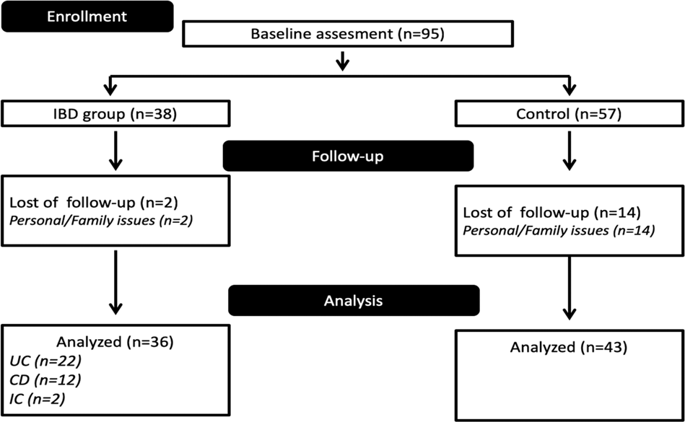当前位置:
X-MOL 学术
›
Eur. J. Clin. Nutr.
›
论文详情
Our official English website, www.x-mol.net, welcomes your
feedback! (Note: you will need to create a separate account there.)
Nutritional status and body composition in children with inflammatory bowel disease: a prospective, controlled, and longitudinal study.
European Journal of Clinical Nutrition ( IF 3.6 ) Pub Date : 2020-01-09 , DOI: 10.1038/s41430-019-0555-1 S Selbuz 1 , A Kansu 1 , M Berberoğlu 2 , Z Şıklar 2 , Z Kuloğlu 1
European Journal of Clinical Nutrition ( IF 3.6 ) Pub Date : 2020-01-09 , DOI: 10.1038/s41430-019-0555-1 S Selbuz 1 , A Kansu 1 , M Berberoğlu 2 , Z Şıklar 2 , Z Kuloğlu 1
Affiliation

|
BACKGROUND
Malnutrition and growth retardation (GR) are major extraintestinal presentations of inflammatory bowel disease (IBD) in childhood and are especially prevalent among those with Crohn's disease (CD). We aimed to evaluate nutritional and growth status and body composition (BC) of children with IBD during a 1-year follow-up.
METHODS
Thirty-eight children with IBD and 57 age- and sex-matched controls were recruited prospectively. Anthropometry (weight, height, body mass index (BMI), and triceps skinfold thickness (TSFT) indicated as z scores for age and sex and mid-arm circumference) and bioelectrical impedance analysis were performed at baseline (T0) and after 1 year (T1). Disease activity was evaluated by clinical scoring systems. GR was defined as HAZ < -2, undernutrition as WAZ < -2, severe malnutrition (SM) as BMIZ < -2, and obesity was defined as BMIZ > +2. A p value of <0.05 was considered statistically significant.
RESULTS
Thirty-six children with IBD (22 ulcerative colitis, 12 CD, and 2 indeterminate colitis) and 43 controls completed the study. Most patients were in remission during the study period (T0:71.4%; T1:72.2%). No significant differences were found regarding the frequency of GR (5.6%/8.3%), undernutrition (11.1%/2.8%), and SM (11.1%/5.6%) between T0 and T1 in the IBD group. The changes in anthropometrics and BC measurements during the study period did not differ between the groups except for the TSFT z score.
CONCLUSION
Most patients with IBD were well nourished and grown, although some children were underweight and had GR. Our results suggest that, in IBD patients, the fat mass (FM) showed a gradual increase over time compared with controls.
中文翻译:

炎性肠病患儿的营养状况和身体成分:一项前瞻性,对照和纵向研究。
背景技术营养不良和生长迟缓(GR)是儿童炎症性肠病(IBD)的主要肠道外表现,在克罗恩病(CD)患儿中尤其普遍。我们的目标是在1年的随访中评估IBD儿童的营养,生长状况和身体成分(BC)。方法前瞻性招募了38名IBD儿童和57名年龄和性别匹配的对照。在基线(T0)和1年后(1年后,进行人体测量(体重,身高,体重指数(BMI)和三头肌皮褶厚度(TSFT),以z分数表示年龄,性别和手臂中部圆周))和生物电阻抗分析。 T1)。通过临床评分系统评估疾病活动。GR定义为HAZ <-2,营养不良定义为WAZ <-2,严重营养不良(SM)定义为BMIZ <-2,肥胖定义为BMIZ> +2。P值<0.05被认为具有统计学意义。结果36例IBD儿童(22例溃疡性结肠炎,12例CD和2例不确定性结肠炎)和43例对照完成了研究。在研究期间,大多数患者处于缓解状态(T0:71.4%; T1:72.2%)。在IBD组中,T0和T1之间的GR(5.6%/ 8.3%),营养不足(11.1%/ 2.8%)和SM(11.1%/ 5.6%)的发生频率没有显着差异。除TSFT z评分外,研究期间人体测量学和BC测量的变化在两组之间没有差异。结论大多数IBD患者营养良好且成长,尽管一些儿童体重不足且患有GR。我们的结果表明,在IBD患者中,
更新日期:2020-01-10
中文翻译:

炎性肠病患儿的营养状况和身体成分:一项前瞻性,对照和纵向研究。
背景技术营养不良和生长迟缓(GR)是儿童炎症性肠病(IBD)的主要肠道外表现,在克罗恩病(CD)患儿中尤其普遍。我们的目标是在1年的随访中评估IBD儿童的营养,生长状况和身体成分(BC)。方法前瞻性招募了38名IBD儿童和57名年龄和性别匹配的对照。在基线(T0)和1年后(1年后,进行人体测量(体重,身高,体重指数(BMI)和三头肌皮褶厚度(TSFT),以z分数表示年龄,性别和手臂中部圆周))和生物电阻抗分析。 T1)。通过临床评分系统评估疾病活动。GR定义为HAZ <-2,营养不良定义为WAZ <-2,严重营养不良(SM)定义为BMIZ <-2,肥胖定义为BMIZ> +2。P值<0.05被认为具有统计学意义。结果36例IBD儿童(22例溃疡性结肠炎,12例CD和2例不确定性结肠炎)和43例对照完成了研究。在研究期间,大多数患者处于缓解状态(T0:71.4%; T1:72.2%)。在IBD组中,T0和T1之间的GR(5.6%/ 8.3%),营养不足(11.1%/ 2.8%)和SM(11.1%/ 5.6%)的发生频率没有显着差异。除TSFT z评分外,研究期间人体测量学和BC测量的变化在两组之间没有差异。结论大多数IBD患者营养良好且成长,尽管一些儿童体重不足且患有GR。我们的结果表明,在IBD患者中,











































 京公网安备 11010802027423号
京公网安备 11010802027423号